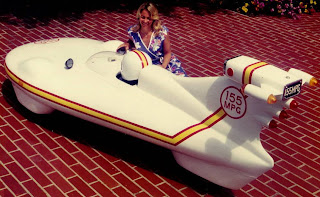EnerTrac Corporation Home Page
The public discussion during the motor development went on here:
Markcycle's Endless Sphere Hub Motor Thread
As this motor came into existence, I realized that it would be a breakthrough powerplant for a high-performance electric reverse trike, that is, a three wheeler with two wheels at the front, provided my vehicle was under the motor's maximum 400lb vehicle weight rating .
That's now the big challenge- keeping the Moonray under 400lbs. It would be rather straightforward to build it out of mild steel square tubing, and then put a wood and fiberglass body over it, but it will weigh 600 or more pounds so constructed. Components, materials and construction techniques all need to be carefully selected and executed to keep the weight down.
Batteries are the single heaviest component. Traditional lead-acid batteries with sufficient power to deliver the 300 amps the motor can take at 120 volts or so would weigh over 500 lbs. The lightest of the new Lithium-based batteries (from A123 Systems and used in cordless power tools) would be about 100lbs for the same amount of power, but they are still incredibly expensive- probably $10k for a pack of them, once I figured out how to get all of them put together. They are hard to deal with, requiring precision assembly of hundreds of about C-Size batteries into a large traction pack, and given the cost and complexity of that, it isn't the way I'll go.
In the last year or so, large format (about 1/4 the size of a car battery) Lithium Iron Phosphate (LiFePO4) cells have become reliable and widely available. They are half again as heavy as the best A123 batteries, but they are less than half the cost, and will be just fine for the Moonray. Moreover, all the skittishness, horror stories and dire warnings the EV community lavished upon early users of these batteries seem now to be quieting down as they are being installed and used to great satisfaction. Jack Rickard, in particular, has greatly contributed to the available information about these batteries by installing, testing and driving them in his converted Porsche kit car- and publishing his data for all to see. The batteries are fine, and they won't need an expensive or complex Battery Management System in the Moonray. Initially, I wanted a 100 mile range, which would have required about 240lbs of batteries. No matter how I work it, that much battery weight puts the vehicle way over 400lbs. I even lost 70 pounds myself, and it isn't enough to make up the difference. I just can't carry more than about 165lbs of batteries, which will cut the range to around 50 miles, but it has to be that way. At least the battery pack will be cheaper...
The design is simple to describe, but the devil is in the details. I will be using the front suspension from a Suzuki LT250R Quadracer ATV, and the rear suspension (swing arm) from a 1985 Kawasaki KZ125 motorcycle. I'll be adapting air-adjustable spring/shocks units from Honda motorcycles- the pair from the rear of a CB900F in front, and just one of two rear shocks from a GoldWing 1100 on the Kawasaki swing arm, which uses only one spring/shock unit. The air-adjustable units will allow me to balance the trike and trim the ride height. I have both the LT250R and KZ125 frames, and I could conceivably just weld them together to make a chassis, but that isn't why I got them. I needed the dimensions of the suspension attachment points to duplicate for my own custom chassis, which will be fabricated from Chromoly 4130 steel. I actually considered welding the motorcycle and quad frames together to build a "mule" chassis to test the motor and battery systems, and it would be a good idea in the abstract, but I think those systems are reliable enough that it would be a waste of time.
Since I'm not a computer-assisted design (CAD) guy, I'll be working with paper and pencil making the Moonray. If I had a CAD-versed collaborator, that would certainly improve the process, but its OK as is and I can't afford the time or expense of the CAD learning curve for this project. To compensate, I'm building the entire vehicle in 1:3 scale, which I am good at, and it does solve problems and refine the design to go through the exercise. The exterior shape will be determined mostly by the wind, but also by the components, configuration, and the available parts I choose, like exterior lights, a canopy, etc. Still, I have a vision of what I want, and some references for styling and aerodynamics that I'm going to follow. First my drawings:
Moonray, 2009- Tom Alvary
Now the three-wheel designs I think are the best to emulate:
California Commuter, 1980- Doug Malewicki
The Polliwog, 1963- Bob and Bill Summers
I'll flesh out my reasons for each choice as we go along, but the initial specification is:
Length: 11-13 feet
Wheelbase: 85"-95"
Width: 49"
Front Track: 43"
Height: 45"
Weight: 400lbs Empty
Capacity: 240lbs.
Speed: 75MPH
Range: 50 Miles
Components and construction materials and details are being collected on a spreadsheet to make it easier to see and juggle the total weight of the vehicle. That's going to be where the all the action is, and on the model, until the basic problem of coming in under 400lbs can be solved...





No comments:
Post a Comment